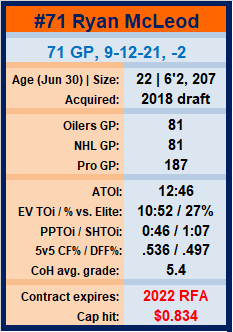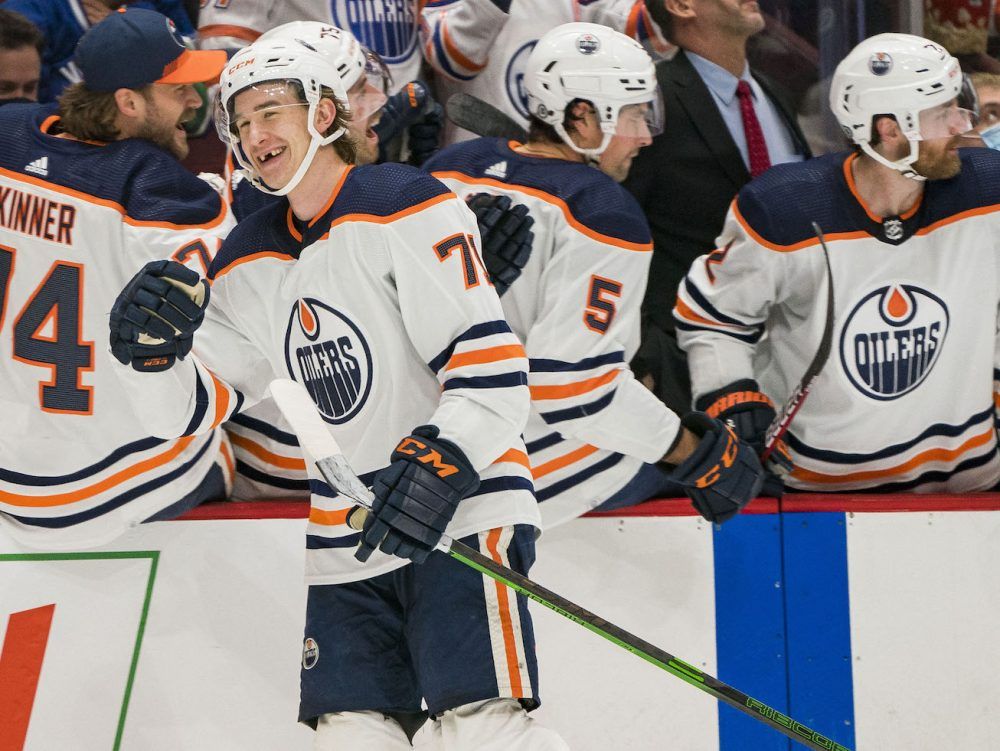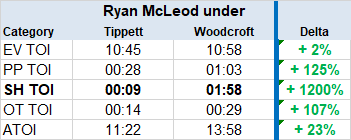
2021-22 Edmonton Oilers in review
Ryan McLeod
Take a look at Edmonton’s club scoring leaders from last season, and you’ll see that 7 of the top 10 are lifelong Oilers. Connor McDavid, Leon Draisaitl, Ryan Nugent-Hopkins, Evan Bouchard, Kailer Yamamoto, Jesse Puljujarvi, Darnell Nurse make a formidable core group. Each and every one of them a first-round draft pick by the Oilers, all but one of them a Top 10 pick.
Sprinkled in there are a few players who arrived in Edmonton as unrestricted free agents and fully-developed players. Zach Hyman, Tyson Barrie, Evander Kane fill out the top 10 and other veteran pros developed elsewhere populate the next few spots.
But you’ll have to let your eye wind a little further down the screen to find a player picked on Day 2 of the NHL Draft. That would be Ryan McLeod, whose respectable 21 points were treble the total of the club’s other 6 rookies combined. That landed McLeod a respectable 14th on the club’s scoring register in what by and large was an impressive rookie season. He’d come a long way during the 3 years of his Entry Level Contract, establishing himself as a bonafide NHLer in the process. But now that contract has expired and he finds himself in limbo, although surely not terminally so.
I’ve long drawn a bold black line between Days 1 and 2 of the Draft, even as the cut-off point is arbitrary (currently 32 picks in the first round). As a general though imperfect rule, first rounders have NHL-level talent and certainly are going to be given every opportunity to demonstrate it. Those picked in Rounds 2 through 7 are are more likely to harbour some identifiable weakness/es and need time to develop.
McLeod is an excellent case in point. He was a high second-rounder with a wonderful combination of size and skating chops right from the get-go, but seen to be something of a perimeter player. His draft number of 38 wasn’t that far below Yamamoto who had gone #22 overall one year previous, but the subsequent handling of the two suggests the Oilers may have drawn some bold black lines of their own.
- Yamamoto would start his Draft +1 season in the NHL, and get returned to junior; then his Draft +2 year in the NHL, only to get sent down to the AHL in-season. Only in Year 3 did the organization get the order right, starting the winger in a lower league and promoting him from there.
- McLeod, like Yam a late birthday, would head straight back to junior (after an impressive training camp) in his own Draft +1 season, then head directly for the AHL in his Draft +2. He “finally” earned his NHL call-up late in a splendid Draft +3 season, and after an early hiccup made the big leagues to stay** in Year 4.
That textbook developmental sequence of a Day 2 draft pick into a full-blown NHL player has been all too rare in this organization. It wasn’t ever thus: there was a time when inspired Day 2 picks like Shawn Horcoff, Jarret Stoll and Fernando Pisani worked their way up to play key roles on a competitive team. They played up and down the line-up, winning faceoffs, scoring points, killing penalties, and blocking shots with their face if need be, all at a very reasonable cap hit.
That last is a crucial part of the plan in an age where teams can’t pay every player $5 million. Best have an internal source of cheaper secondary players who can hold their own in the bigs, and once in a while even develop a star.
Alas, it’s been a critical shortcoming since that early 2000’s group, with lots of wannabes, a few regrettable trades of both prospects and future picks, and the inability to sign promising selections like Toby Rieder, Erik Gustafsson, and John Marino. Whether it’s cause or effect, management has consistently felt the need to go outside the org to bring in role players that for whatever reason couldn’t be developed within.
Let’s gloss over most of the gory details and jump all the way forward to the season before last, when the last group of home-grown hopefuls fired and fell back. Here’s a full accounting of Day 2 picks who played for the Oilers in the 56-game 2021 season:
All of these draft picks preceded Ken Holland’s arrival in Edmonton. Heck, the guy at the top of the list was drafted by Steve Tambellini and signed to pro contracts by each of Craig MacTavish, Peter Chiarelli and Holland!
But in his Draft +9 year Jujhar Khaira scored just 3 goals and Holland had seen enough. Meanwhile, 24-year-old defenders Ethan Bear and Caleb Jones each became trading chips in controversial deals that brought established NHL veterans the other way. And just like that, 3 of Edmonton’s most promising depth picks of the prior decade found themselves on new NHL clubs. The roster of internally-developed candidates for depth roles was pared to the bone.
We do see on this list the arrival of McLeod, who earned a late season recall and made the most of it in a 10-game trial plus 4 more in the post-season. A bit of centre, a bit of wing, a bit of all over the place, mostly in a 4th line role. His most common linemates were James Neal, Alex Chiasson, Josh Archibald, Devin Shore — depth guys acquired from other sources, as was the Oilers way.
McLeod wasn’t a threat to score but even in that short run his game was visibly growing. A good thing, too; after the clearout sale of Khaira, Jones and Bear, his 10 NHL games made him the second most experienced big-leaguer among the Day 2 guys in the entire organization.
The only guy ahead of him, 2014 draftee William Lagesson, wouldn’t survive the 2021-22 season. He was dealt at the deadline with picks for another big-league vet in Brett Kulak.
McLeod himself was, and remains, in no danger of being swapped out. After losing the numbers game in camp — due in large part to his being the only waivers-exempt forward on the roster — he put in 7 strong games under Jay Woodcroft in Bakersfield, then returned to Edmonton game-ready and raring to go. Since then he’s become an everyday player popular with teammates and fans alike, not to mention a strong contestant for Hockey Smile of the Half Century.
- Edmonton Oilers forward Ryan McLeod (71) celebrates his goal against the Vancouver Canucks in the third period at Rogers Arena in Vancouver on Jan. 25, 2022. Oilers won 3-2 in overtime.
A dispassionate observer assessing McLeod’s season might suggest he was pretty average. His 9 goals and 21 points both scraped into the top 300 among NHL forwards, just on the cusp between third and fourth line production. The good news being that he did so as 1) the youngest forward on his team 2) in his first NHL season 3) on a cheap contract. The overarching impression was that he’s hardly done improving at the tender age of 22.
In the first half of the season under Dave Tippett, McLeod established himself as an everyday player but struggled to find a meaningful role over and above bottom 6 minutes at 5v5. But when Tippett was fired at mid-season and replaced by Woodcroft, McLeod suddenly had a coach who knew, and trusted, the breadth of his game. His ice time soared on both special teams but especially the penalty kill:
McLeod’s even-strength time barely wavered, but he saw his ice time in other high-leverage situations double or more, and his overall ice time jumped by 23% under the new regime.
In particular his PK work was an eye-opener. He went from an afterthought somewhere behind veterans Colton Sceviour and Devin Shore on the depth chart all the way to the first unit. Moreover, he posted excellent goal suppression results. In the process, the Oilers kill rate soared from 80.6% under Tippett (22nd in the NHL at the time) to 87.0% under Woodcroft (4th). Lots of other contributing factors in that improvement, but McLeod’s impact was a significant one. He seemed a natural on the PK with his splendid skating, excellent size and reach, and ability to transition the puck by lugging it himself when the opportunity arose.
At 5v5 he was roughly a break even player in a utility role. He spent time at 4C, 3C, 2LW, and also served as an extra forward in an 11/7 line-up who could effortlessly transition from centre to wing to complement the preferences of his linemates on a given shift. Worth noting that as per PuckIQ.com, Woodcroft bumped his ice time vs. Elite opponents to 30% compared to 24% under Tippett with no deterioration in results.
McLeod’s “fancy stats” profile nonetheless paints a picture of an incomplete player. His on-ice possession numbers were sound with a 54% share of shot attempts and 52% of actual shots. But those shares fell off to slightly below 50% in such key indicators as high danger chances, dangerous Fenwick, expected goals, and most importantly, actual goals. Conclusion: the puck spent a good amount of time in the right end of the ice but didn’t necessarily penetrate the slot.
That last remark mimics the general criticism of McLeod’s own game right from his draft day, that he plays too much on the periphery and not enough in the trenches. Turns out the “fatal flaw” isn’t fatal after all, he has survived nicely even as his inside power game is very much a work in progress. But there’s no denying progress is being made.
Looking ahead
All of which has likely earned McLeod a healthy raise on the $834k (including signing bonuses) he commanded in 2021-22. Trouble is twofold: the club has very little room to manoeuvre, and the player has precious little negotiating power. Unlike Puljujarvi and Yamamoto he is not yet eligible for arbitration, nor does he yet have the kind of numbers that would command a big raise.
For precedent, we only need track back one year to the summer of 2021, when Yamamoto was in a similar boat. The club waited him out while first attending to other business which among other things, determined how much/how little cap space was available. The two sides waited until the third week of September before finally coming to terms on a 1-year deal at a club-friendly price.
A similar outcome likely awaits Ryan McLeod. As a first time RFA he is in the “value contract” stage of his career curve. Best thing he can do is to sign that contract, likely in the $1.0 million range, then deliver as much value as possible to establish a much stronger negotiating position a year from now. For now business is business, even as there’s no question he is in the Oilers’ plans for 2022-23 and beyond. Ideally far, far beyond.
Source: EdmontonJournal








